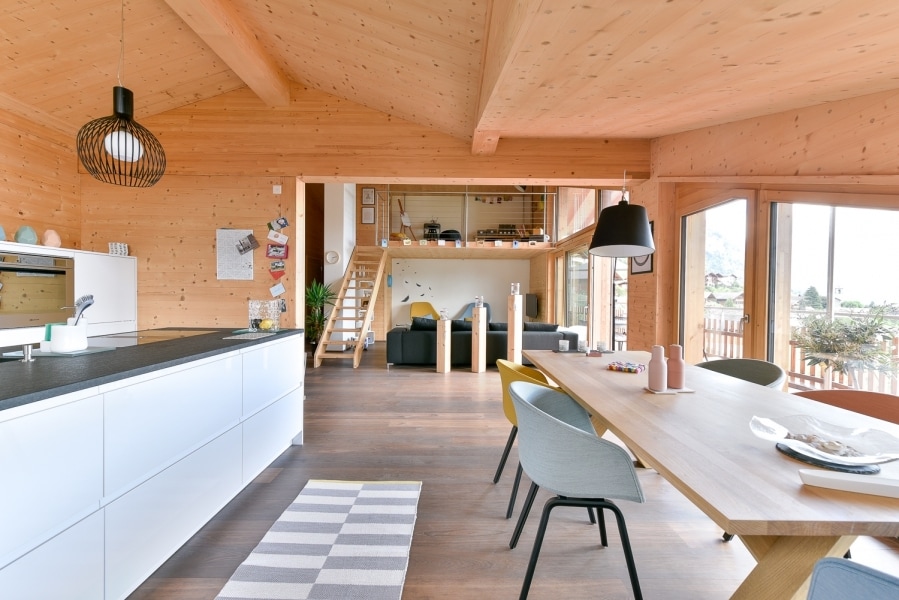|
THE ETERNALLY DUSTY STAIRWAY Think about the static when you pull a synthetic jumper over your head, or how synthetic carpets get charged just by walking on them. And of course, it's followed by an electric shock when reaching for the doorknob - the corresponding discharge. Electrostatic charge is caused by dry and heated air moving past non-conductive synthetic surfaces. The resulting load is larger if the surface is less conductive. You rarely experience this with natural materials like pure wool or linen. Electrostatic charge is caused by dry and heated air moving past non-conductive synthetic surfaces. The resulting load is larger if the surface is less conductive. You rarely experience this with natural materials like pure wool or linen. 'Building biologists' make sure that there are as few electrostatic chargeable surfaces as possible in living areas. The human body in itself naturally has a weak electric shield surrounding it. This weak electric field repels dust, dirt particles and bacteria, etc. Rooms with a strong electromagnetic charge disturb this natural protective field and those who are sensitive can experience allergies, inflamed mucus membranes, colds, headaches, etc. In Europe, this is called the 'sick building syndrome'. Another disadvantage of statically charged surfaces is the tendency to attract dust and dirt, like the surface of a TVs or stereo. But this problem is easy to solve - just make sure you have as much natural and untreated wood in your home as possible. If you want to treat wooden surfaces, use only natural bees wax or resins. Floors, walls and ceilings made of untreated wood will not affect the natural occurring electromagnetic fields in your home negatively. This characteristic is one of the reasons an old alpine cabin feels so much more comfortable than an apartment with painted surfaces. Here is a short story of a young couple in our neighbourhood: a couple of years ago, they experienced an interesting phenomenon in an unexpectedly. When their home was built, the contractor installed a floor made of ash wood in the entry area of their house. The surface of this floor was then treated with natural resin and bees wax. The staircase in the foyer connected the rest of the house with the entry area and was built by another carpenter who laquered the stairs with a commercial water-based product. "Horrible", the wife complained. These stairs act like a dust magnet, it seems they attract all the dust from the whole house. The waxed and oiled floors in the other rooms do not, just the staircase was forever covered in a layer of dust. The wife would mop it three times a day and complain about it many times. Her husband finally promised to take off the varnish and oil as he had done with the other floors. There was no doubt that she would insist on him doing what he promised to do. WHAT IS MORE HYGIENIC? An American study called "Plastic and Wooden Cutting Boards" by Dean Oliver, Ph. D. in his research of salmonella and kitchen cutting boards showed drastic results. Salmonella actually dies after a few minutes on a natural, untreated woodcutting board, whereas plastic cutting boards encourage salmonella to thrive and increase in population. Think about laminated kitchen counters and cutting boards which many people think are more hygienic than untreated wood. WHAT EMITS RADIATION IN A HOME? This is not about the sun's radiation, it is about comparing all types of radiation which people are exposed to in daily living situations as a consequence to the building materials which have been used. We conducted a research on average exposures to radioactive radiation through naturally occurring sources vs. man-made/artificial sources. The average radiation exposure in Germany is 150 millirem (mr). Just by living in homes with a variety of individual building materials, the following has been recorded: Granite/Slag: +150mr = 300mr Plaster: +65mr = total 215 mr Brick and Concrete: +20mr = total 170mr Natural Wood: -10mr = total 140mr The only building material which can actually lower radiation is natural wood.
0 Comments
Leave a Reply. |
AuthorHolz100 Canada Inc. Archives
July 2019
Categories
All
|
HoursMon - Fri.
9:30am - 4:30pm |
Office |
President FRANK GHAHREMANI(416) 725-6747
|


 RSS Feed
RSS Feed


